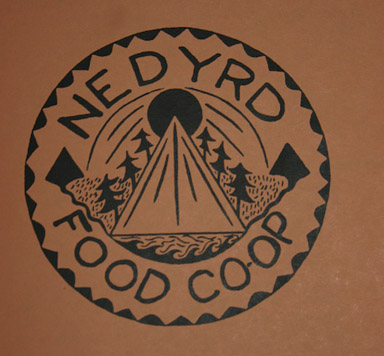April 24, 2008
Remembering Nedyrd Co-op
Our efforts to eat locally keep reminding me just how important the connection between people and food is. Over the past century, our country disconnected itself further and further from the food foundations it started with. Starting in the 1960s and 1970s, though, some folks noticed what they were missing, and some of those people were in Dryden.
Margaret Brownell Lorenzen, founder of the cooperative, led the discussion, and then lots of other people who had been involved added their own memories. The following is a summary - please let me know if I've gotten something wrong!
Nedyrd started in 1977, and closed in 1992, though it took a long time after 1992 to finally dissolve the corporation.
Margaret Lorenzen got the idea when she went to a conference in New York City, which had workshops on how to hold a local food day (which she also did) and how to start your own food cooperative. Dryden residents who wanted food beyond the usual had to drive to Cortland or Ithaca, and often found it expensive in any case. She and her husband printed up 1000 fliers and distributed them with the help of local children.
A group of residents came together as a result of those fliers, and got started as a buyers' club, meeting in the Presbyterian Church. Lorenzen attended meetings at Greenstar and another cooperative in Geneva to figure out how the ordering worked. They put together orders for bulk, and then had to meet a truck with their own containers to collect the food. If they had almost enough for an order, they'd place the order and save the leftovers. If they didn't have enough for that to make sense, they'd wait to place the order. Early on, they also took orders for fresh fruits and vegetables, though that didn't last very long because of constant price changes. (Gina Prentiss remembered being amazed at how little they cost, though!)
The leftovers accumulated, and they moved them to a back porch. Then they moved to an old and trashed house where the A-1 parking lot now is, and spent some awful time cleaning it. Then they moved to 2 East Main Street, later the Villa Trinceri, around 1980.
The emphasis was on whole foods, foods that hadn't been processed to remove their food value. Lorenzen noted flour in particular as a food we process severely, losing most of the nutrition, and there was some discussion of the mills the cooperative got flour from, including New Hope Mills up in Moravia and another in King Ferry. All these grains meant they had a huge challege in fighting off flour moths, which would arrive in the products and then reproduce in the store.
Cheese, molasses, and peanut butter also came up as popular items.
They didn't make a lot of money. Lorenzen remembered a lot of negative balances, and a 1989 Ithaca Journal article suggested a lot of zero balances. Because of their cooperative structure, they could only sell to members. Members who worked in the store (I think two hours a week) paid $12 annually, and it was $30 for non-working members and $6 for senior citizens.
Markups were low, originally 5%, and some goods, like spices, seemed especially cheap but had great quality. Dryden Town Historian Sue Olmstead said that she joined the co-op to take advantage of the prices, but ended up learning a lot about nutrition.
The cashbox and keys were kept at Hill Drugs, next door to the Dryden Food Mart on Route 13. Members used a set of labeled shoebags to collect orders, and five-gallon buckets were a key part of the operation. There were some spiral notebooks used to record the comings and goings.
Muriel Likel remembered the friends she'd made working at Nedyrd, and Gina Prentiss reflected on the early conversations there which led to the creation of the Dryden Town Historical Society.
As time passed, it got harder to sustain the co-op. While Lorenzen emphasized that "I just can't tell you the feeling of community among the members," she also described changing times that made it harder and harder to keep it going. The 1990s were "more stressful," with more people working, making it harder for them to commit to work at the store. New member orientation was sometimes the last they'd see of a new member. Founding members' families had grown up and moved away, reducing demand. Missed shifts meant the storefront was sometimes closed when it was supposed to be open.
Jean Warholic reflected a bit on the challeges of dissolving Nedyrd, describing the maze of state bureaucracy she had to navigate. Mike Lane helped out with advice, while former Assemblyman Marty Luster provided some necessary pressure.
It sounds like the co-op considered closing a few times before it finally did, in the end selling much of its equipment to Kathy and Rich Duell, who started a store, The Olive Branch, specializing in local food and handcrafts while maintaining the bulk food ordering of Nedyrd. That only lasted a few years. There was another store (whose name I missed), and today we have Back to Basics at the intersection of 13 and Irish Settlement. Back to Basics' Kim Schenk was at the event to share her memories of Nedyrd as well. As she put it, "we just figured out how to do it, working together."
A number of people mentioned the Dryden Community Cafe, which seems to working much like that today.
I've posted a small gallery of photographs from the evening.
Posted by simon at April 24, 2008 8:45 AM in Village of Dryden , historyNote on photos
